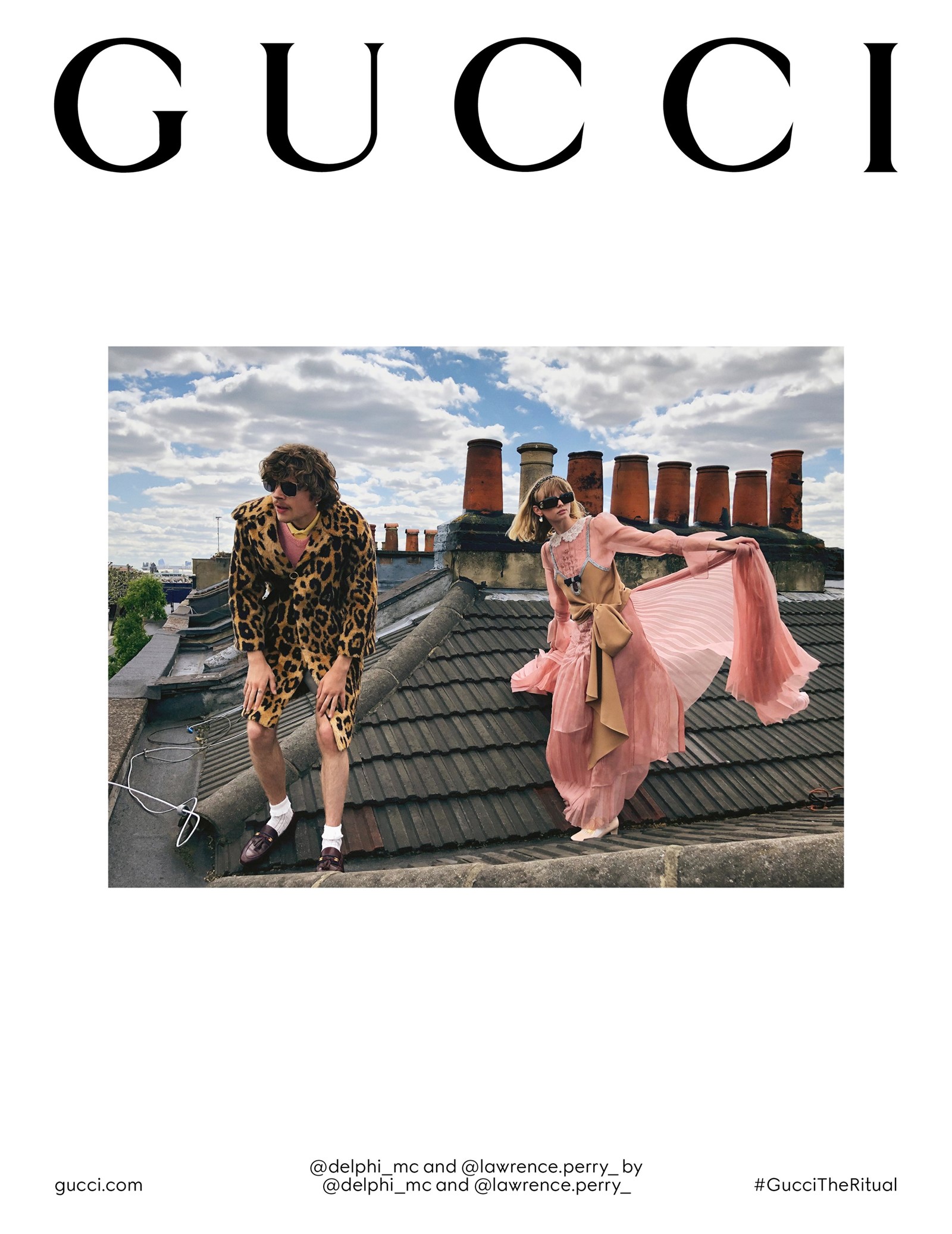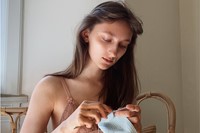This article is published as part of a new series of Designer Interviews, where we’re speaking to some of the industry’s most crucial voices about this current – and highly unique – moment in fashion history.
“This time was the time to reveal how powerful human beings are. That idea of humanity. Fashion is humanity” – Alessandro Michele
Alessandro Michele is interested, always, in shifting our point of view – in challenging, provoking, and playing. His Autumn/Winter 2020 Gucci show put the backstage centre stage – the make-up was front-of-house, while a transparent scrim revealed the process of dressing the models, “making the heartbeats visible,” in Michele’s words. It also made their entrance to the catwalk suddenly become not the start of a vision, for the audience, but its climax, upending fashion conventions, perceptions and expectations. Turning the tables. And it played out to the words of Federico Fellini, another great Italian showman.
Michele decided to continue doing that for his latest Autumn/Winter 2020 Gucci campaign. Rather than the obsessive auteurship of a figure like Fellini – which Michele freely admits he usually revels in – he instead surrendered control to a selection of models and characters from that show, encouraging them to create a series of intimate self-portraits that decontextualise Gucci in the everyday, an idea Michele has always been fascinated by. There were no make-up artists or hair stylists, no photographer even. Michele decided on this “experiment” (his word) way back when, in the planning of that spectacular February show – and before the Covid-19 pandemic made the process of shooting conventional fashion imagery impossible. He called the campaign “Rituals” – and it celebrates the rituals of the everyday – dressing, living. Rituals that have been, somehow, interrupted.
In an exclusive conversation for AnOther Magazine from his home in Rome, Alessandro Michele unpacks the concepts and process behind this latest campaign, his ideas of creativity, humanity and his thoughts on the moment.
Alexander Fury: Hi Alessandro – are you back in the studio?
Alessandro Michele: No, not really. I’m still working at home. I’ve been in the studio just one day. I discovered that I can really work in a very deep way also from my flat, from my home, and it’s really interesting, because it’s like ... we already had the skills to do things in a different way ... I remember when I started working fashion, and I’m almost at the same place, I’m working the same way. That’s crazy.
We are all discovering different things. I’m also discovering that, for a long time, I didn’t have the time to do the beautiful nothing. Where are you? In London?
AF: In London, in my house. In lockdown.
“We are all discovering different things. I’m also discovering that, for a long time, I didn’t have the time to do the beautiful nothing” – Alessandro Michele
AM: Today, in Italy, the lockdown, it’s over. And outside in Rome, it’s almost the same. Noises, cars, voices, people walking. I live in the centre of the city.
AF: I think that’s happening here this week. I’m not sure how busy it’s going to get, but it’s becoming a little bit more like normal. A new normal.
AF: I wanted to actually start off a bit by talking about what we were just talking about – the way we’ve all been living for the past few months. That is really reflected in the new Autumn/Winter Gucci campaign as well – a series of self-portraits, shot by the models themselves. Has this period of confinement changed the way you create? Do you think it’s changed your creativity or your viewpoint on the world?
AM: It’s so strange, because it’s just that this strange time gave me the chance to experiment, to do something that I really wanted to do. It was never the right time. Before the lockdown forced everybody in this kind of situation, at the last show in Milan, there was a kind of a strange creation. I was thinking [for the campaign] maybe we must work in the same way, changing the perspective in the same way I did for the show.
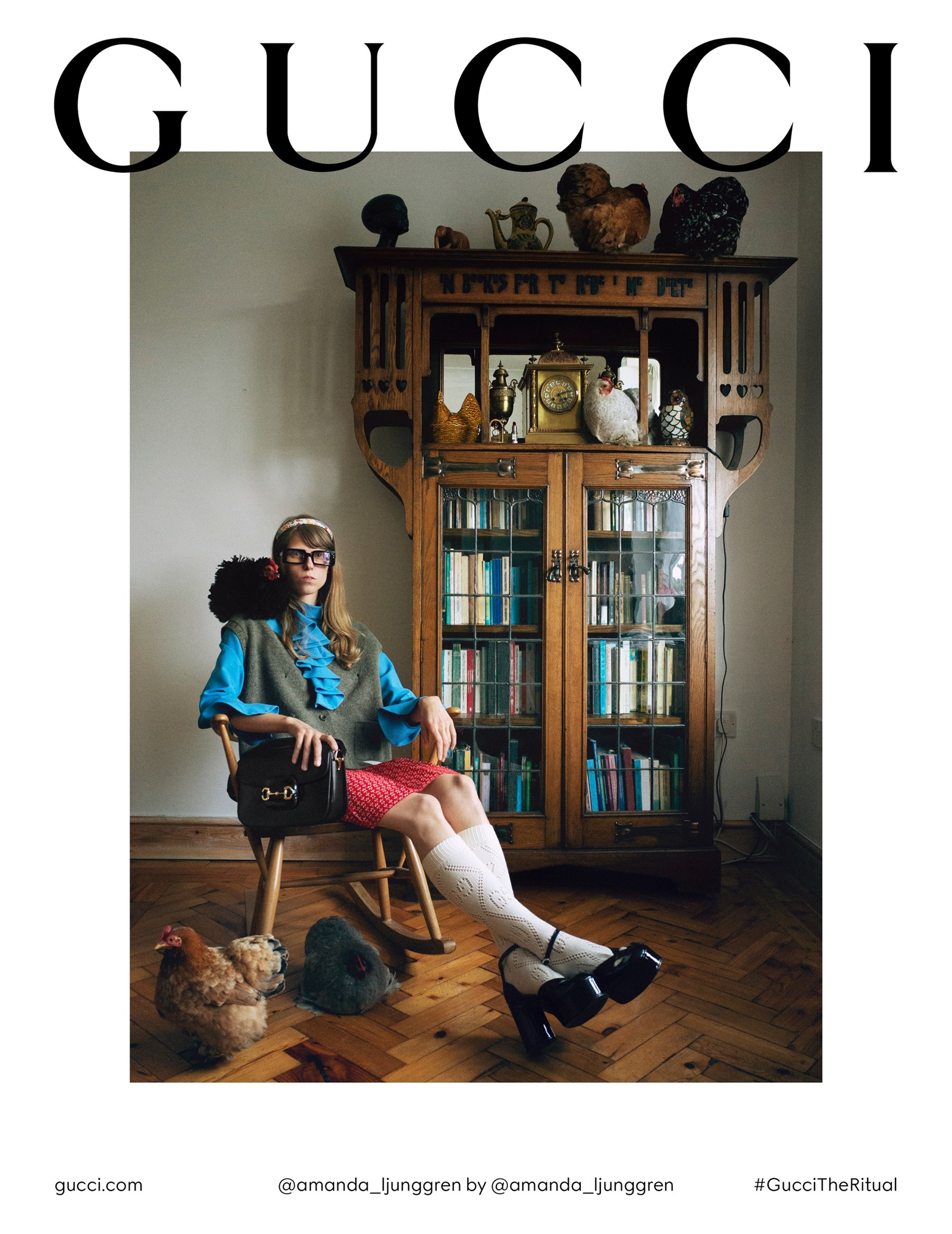
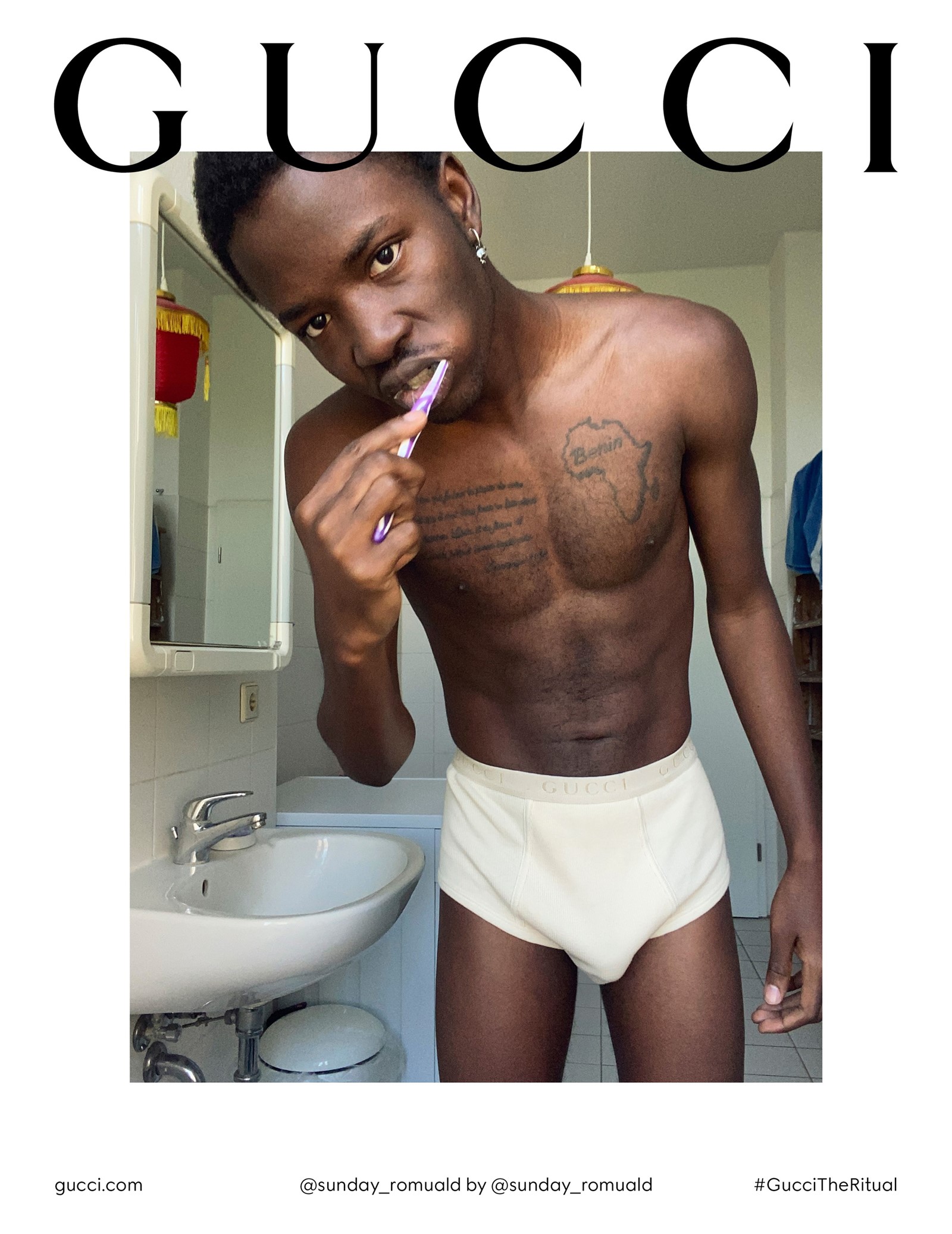
Now, when I see the image of the campaign, it’s like that’s the only way that I was able to work. But the reality is that I started the campaign during that work in Milan, on the show. Because I was thinking in the same way, working from another perspective to reveal the hidden part of the work. I was thinking what would happen if we change the perspective in the campaign, as I really wanted to do for a long time, to work in a different way?
I wanted to stop being the obsessive director of the image. The models were actors in my imagination: I work it as a director. I was thinking, ‘what happens if I do what Andy Warhol did?’ I try to see what happens if my creativity is just the work that I can plan, before the experiment?
I tried to change the point of view, and so I tried to get inside the lives of my guys. I didn’t use them as just models, but I used them as characters. I wanted them to be the director of themselves.
AF: Did you have any idea what you were going to see – what the images were going to look like, before they arrived?
“I tried to change the point of view, and so I tried to get inside the lives of my guys. I didn’t use them as just models, but I used them as characters. I wanted them to be the director of themselves” – Alessandro Michele
AM: No. No. No. I was thinking that’s not the right experiment. Let’s see what fashion can manage, change, and be in their proper place, in houses, in their lives.
You know what, when I worked on the direction of the [Autumn/Winter 2020] show in Milan, there was a part that we cut off. There was the idea that the models went out from the carousel. I was thinking with my partner, Vanni [Attili], that at the end that they could take a seat between the people, the audience. So that after the show, it’s like the fashion will be between us, alive.
AF: Real life.
AM: So, honestly, I was really at home [Michele was working from home in Rome during the lockdown], with all the people that work with me, just waiting for the image. I just push the campaign characters to do the things that they usually do in their house, and to feel themselves. Just don’t forget the idea that we must show a collection!
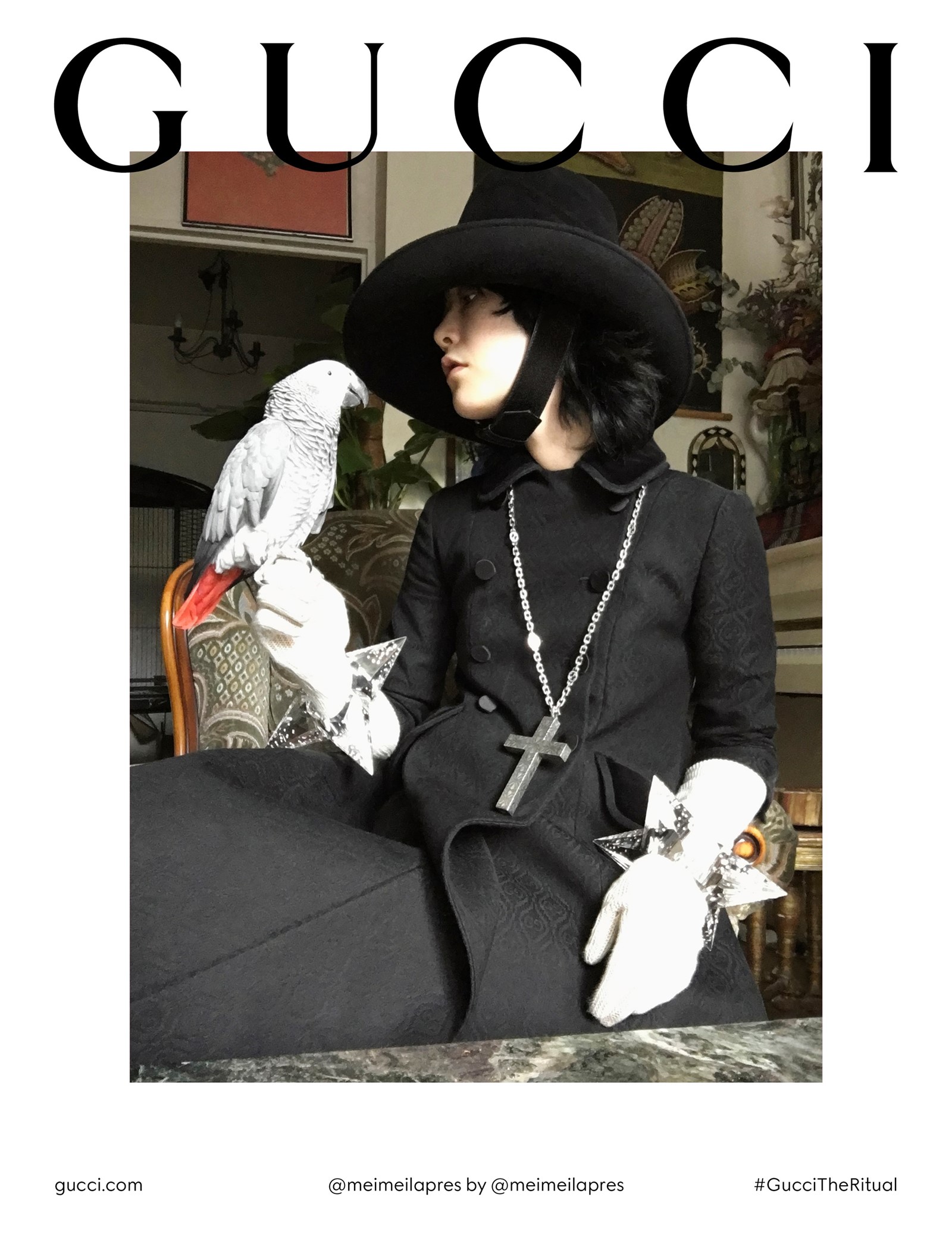
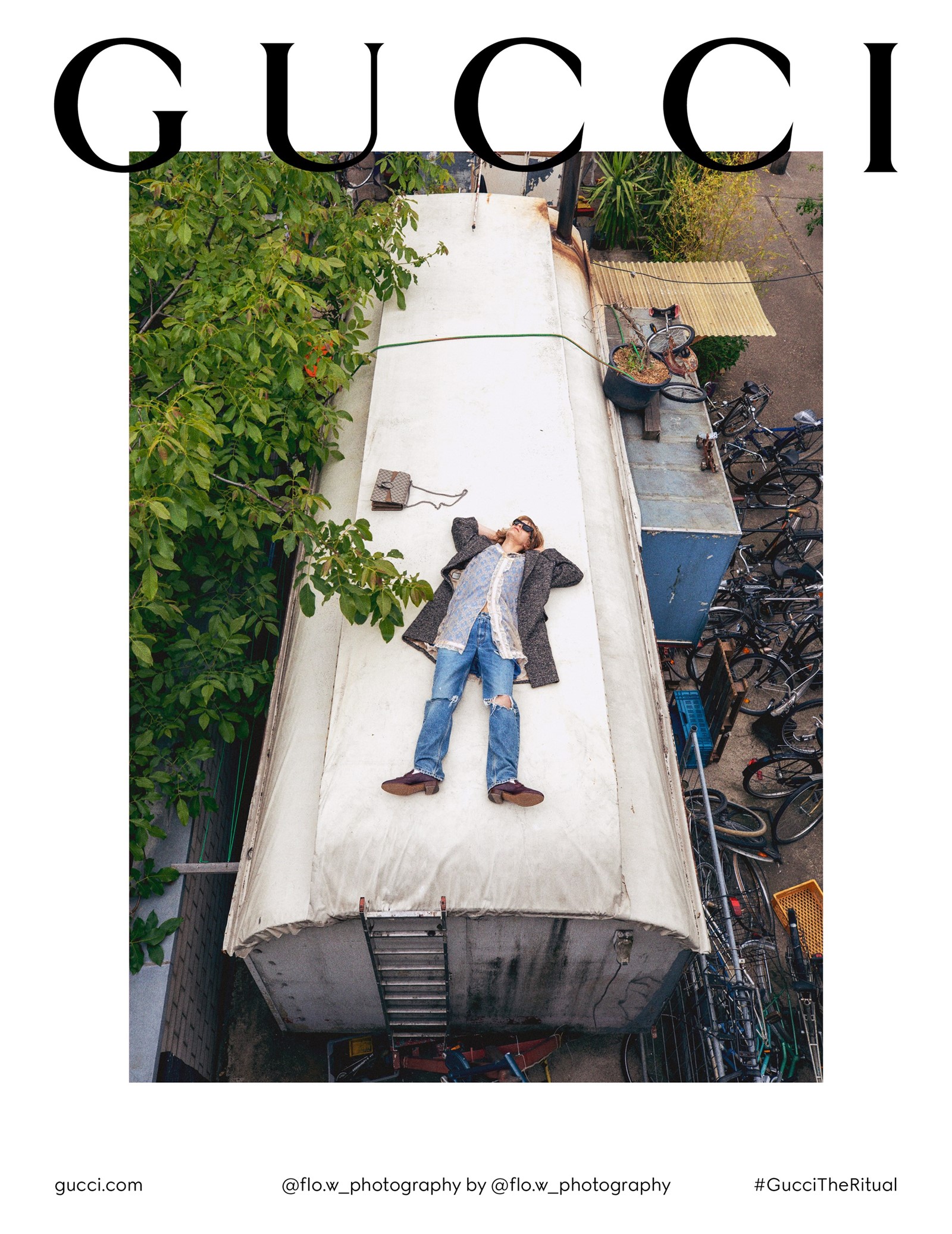
AF: Well, I think the interesting thing with a self-portrait thing is it automatically becomes your own perception of yourself. Here, we’re in conversation via video – you’ve chosen your background, I’ve chosen mine ... It’s these perceptions of the self. And that’s what’s very interesting about this. It’s their own perceptions of themselves, framed with Gucci.
AM: That’s interesting. It’s beautiful. When I saw what they did, it’s unbelievable. I mean, when I saw Florian (@flo.w_photography) on the roof of the van … Because at the end, Alex, I am in fashion, but also, I’m trying always to replicate reality.
I was really surprised. All of them, they had a pet; a parrot, a cat, a dog! It was so Gucci. When I saw Mae Lapres (@meimeilapres) in her apartment in Paris – I mean, that’s more Gucci than the reality that I create with the imitation, you know?
“The language – it’s like Andy [Warhol], when he put the camera in front of the bus stop, spying on people. I feel myself like a voyeur. I’m a person that loves to spy on people” – Alessandro Michele
AF: And you are in the campaign yourself?
AM: I’m a really bad singer and I’m also shy, but they have, in the campaign video, a tiny, tiny, tiny piece of me. It’s something that I really hate. But at the end ... I’m a very private person, but I was thinking, fashion is something that maybe has to reveal more.
AF: It also ties in with the show – at the show, the behind-the-scenes processes became kind of a performance. So it’s quite natural that you become a performer in a sense. And also, I think, as a designer each collection is, in a way, a self-portrait of you.
AM: When I was in Milan, I directed everything. And I was like; so what will be about me during this performance? Where will I be? Maybe I will be inside because I will be working as usual in front of the monitor. That’s the experiment – we were the show of the people outside, and they were our show. It was unbelievably beautiful, being inside and looking at you all around.
So at the end I was, as you were saying, I was working on the campaign, I was with them. We work in a different way, experimenting. The language – it’s like Andy [Warhol], when he put the camera in front of the bus stop, spying on people. I feel myself like a voyeur. I’m a person that loves to spy on people. I think a lot of people that work in fashion do.
AF: They are interested in other people, in the way they look.
AM: You want to live other lives. I must spy! I need crazy friends, people that can live. I can live other lives through their eyes. I usually say that I love pornography – I love things that I don’t usually do. The idea that I was spying in [the campaign models’] houses. But I didn’t want to direct, I was just saying: do what you want, be the director of yourself, be the producer of yourself, be the actor, be the owner of your home, of your life. Let’s try to see what happens.
AF: A thing that I found very interesting was that, obviously, it’s about individuality – because it’s each individual taking pictures of themselves. But there’s also this idea of a community, of kindred spirits.
AM: That’s so true, it’s exactly what you were saying. I don’t know if you remember the words at the end of the show in Milan: there was Federico Fellini, talking about the way he worked. “A movie camera, some friends around willing to help, a crew, an extraordinary crew. A circus crew, really.” I really felt also in Milan that all of us, me, you, everyone, we are the same community, loving the same things. And in a magical way, in this time, particularly in this time, we were all very close to each other.
“For the campaign … it would be easy also to call friends of mine, famous friends. I’m not that kind of person. It’s these people because I need to say something precisely” – Alessandro Michele
For the campaign … it would be easy also to call friends of mine, famous friends. I’m not that kind of person. It’s these people because I need to say something precisely.
AF: I think this whole situation has focused attention, made us all precise. Now things are maybe being given the attention they wouldn’t have been otherwise, especially when we’ve been deprived of things – of freedom, of contact.
AM: We are discovering that there is something really powerful around this huge story. Maybe my campaign could look very simple, but I’m feeling that it’s the most powerful thing that I did in the last few years. One of the things that I really love is to create images. I think that you know very well that I’m not really obsessed as a tailor with the length of a skirt. For me, there is always a story. It’s not just the way you look. I don’t care.
This time was the time to reveal how powerful human beings are. That idea of humanity. Fashion is humanity. We are human, me, you, we are all human. They are human. There is something powerful about fashion that we discover, and we didn’t know. Maybe we felt it, but we didn’t have the chance to say it as clearly as we are saying now.
Gucci Autumn/Winter 2020 collection. Creative Director: Alessandro Michele. Art Director: Christopher Simmonds.
Video Music: Sony/ATV: Alright. Writers: Gareth Coombes, Daniel Goffey, Michael Quinn © 1995 EMI Music Publishing Italia Srl on behalf of EMI Music Publishing LTD. BMG: Supergrass. Alright (P) 1995 The Echo Label Limited, a BMG Company. Courtesy of BMG Rights Management (Italy) Srl.
